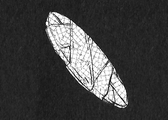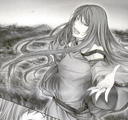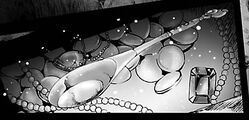| 🛠 | This subject is work in progress. Please bear with us while improvements are being made. For information on how to help, please contact an admin. More subjects categorized here. |
🛠 |
Magic was the supernatural power employed by certain beings and societies throughout the history of the Third Period. Capable of performing the otherwise impossible, the art of magic was practiced by both gods and humans, although waning in practice and belief in the Third Period following the Levianta Catastrophe.
History
Early History
During the Second Period, the advanced technology of earthling societies was able to achieve seemingly impossible feats, such as the manipulation and movement of someone's soul and the creation of artificial life. After the construction of the Third Period, the Second Period technology brought to facilitate its creation was buried in the northern region of Evillious around BT 528.
Magic as a practice also became widespread among the humans of the Third Period, allowing practitioners to achieve physically impossible feats without the aid of any technology at all; similarly the earthlings who had arrived at the Third Period reincarnated into various magical forms, including gods, demons, and forest spirits.[1]
Golden Age
Not long after their societies began to form, humans of the Third Period began excavating the legacy of the Second Period, regarding the advanced technology as magical in origin. They congregated around Sin and founded the Magic Kingdom Levianta at the site of its excavation. Utilizing the super technology and worshiping the gods Levia-Behemo, the Leviantans developed into the most advanced magical society in the world. As time progressed, the study and practice of magic became widespread on the Bolganio continent.[2]
Decline
After Levianta's destruction in the Levianta Catastrophe of EC 013, a vast majority of mage families were wiped out, leaving only the shamans scattered around the Evillious region and the few surviving bloodlines settling on the outskirts of Levianta's territories.[3] As the centuries progressed, magic became a rarer and rarer art and shamans began to die out with the rise of formal medical professions.[4]
By the 6th century EC, magic was regarded as little more than myth. As time continued to pass, magic use continued to diminish in the Evillious region and only a handful of practitioners existed.[5] The 10th century EC saw a return of widespread belief in magic as a response to the breaking down of the rules of the Third Period.[6] Similarly, although individuals with real magical talent remained low in number, the century saw a rise in magic practitioners.[7]
Mechanics
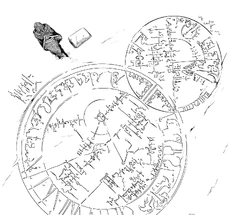
A reincarnation ritual circle
At a certain level, magic was omnipotent and had the potential to do anything imaginable, allowing it to create or bend the natural laws of the universe if given the appropriate time and effort. Due to its metaphysical nature, it was able to manipulate life and the elements or create something entirely out of nothing.[8] In the Third Period, magical power was greatly influenced by the moon; magical power grew with the moon's waxing, becoming most powerful at the full moon, and conversely grew weaker as the moon waned.[9]
Magic existed within select individuals or bloodlines and was passed down onto descendants throughout the generations. As a result, magic users' magical talent and ability varied and most humans had little to no magical power at all.[10] As such, only individuals born with great magical talent were capable of performing complex spells, while others would have extreme difficulty even casting simple spells.[11] Compounding this, individuals called "inheritors" could allegedly inherit certain powers of the gods.[12] In contrast, gods, spirits, and demons held a great amount of magical power and could perform a plethora of techniques and spells that humans could not.[13] Gods and demons could also lend their power to humans even if they lacked any innate magical ability.[14]
As a result of possessing magic, users were able to detect and recognize magic in other beings or objects and could feel a certain of difference between a magic user and a regular human.[15] Likewise, unique magical abilities that could manifest in certain bloodlines could be continually passed down within the clan to preserve its existence and use.[16] Similarly, objects could be created and imbued with magic, making these "magic tools" or devices serve some practical use for even an owner lacking in magical ability.[17]
Combat
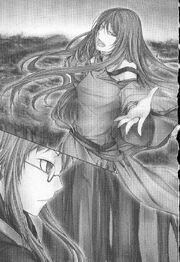
Two mages in battle
Whether through arranged duels or informal encounters, numerous mages entered combat with other mages or similar magic users. Because magic relied so heavily on the moon, mage combat on the night of a full moon was both the most advantageous and risky, putting both parties at their most powerful.[18] Due to the flexible utility of magic, a majority of magic types were useful for combat.
Tactically, mages took on a variety of approaches to battle; some preferred to place most of their magic power early on and quickly overwhelm the opponent while others preferred to conserve magical power and draw out fights until finding an opening in the opponent's attacks. Because of the required focus and time needed to perform some spells, mages could falter under pressure and be forced to be on the defensive.
The environment was also extremely important for mage combat as some magic relied on preexisting elements to cast or supplement their spells, leaving a mage powerless in certain environments. Likewise, mages were especially susceptible to ambushes, assassinations, and traps if not properly prepared. If properly set up, a mage could quickly turn a battle to their favor before the combat even actually began.[19]
Practitioners
Sorceresses
Sorceresses, also known as mages, were formally trained spellcasters and the most common practitioners of magic, consisting of men and women. They could learn from a variety of different magics, making them particularly diverse in their specialization.[20] Many of them formed clans specializing in certain magics or blood-inherited magic abilities,[21] and were often considered bewitchingly beautiful people.[22] Sorceresses and mages were originally numerous during the reign of the Magic Kingdom Levianta; following the Levianta Catastrophe, the surviving mages' knowledge slowly died out over time.[23] They eventually became considered the product of fairy tales and fiction.[24]
Shamans
Shamans were medicine men or women specializing in healing. Shamans used their magic ability to give them a stronger connection with the natural and spirit worlds, allowing them to communicate with both spirits and gods.[25] Using their knowledge, shamans studied the practice of conventional medicine and used their craft to help heal injuries and sickness or relieve pain. They largely existed in Elphegort and were members of the Held sect. Following the Levianta Catastrophe, humans continued to advance technologically and require "formal" medicinal licenses for taxing, leaving shamans to slowly die out over time.[26]
Witches
Witch was a term typically associated with powerful and typically malevolent magic users. Witches were often associated with death and destruction.[27] Like mages, witches died out in the years following the Levianta Catastrophe.[28] Belief in witches later resurged in the late 10th century EC, with witches being blamed for the strange phenomena all over the world.[29] As part of the belief, the term witch was applied to all magic users regardless of gender.[30]
Spells and Powers
Tools and Devices
Appearances
- Queen of the Glass
- Project 'Ma' (song)
- Escape of Salmhofer the Witch
- Ma Survival
- Whereabouts of the Miracle
- Recollective Musicbox
- The Song I Heard Somewhere
- The Lunacy of Duke Venomania
- Judgment of Corruption (appears in PV)
- The Muzzle of Nemesis
- Neomaria of the Inverted Gravestone
- Swear an Oath on that Bridge
- Twiright Prank
- Tree Maiden ~Millennium Wiegenlied~
- Blink
- Handbeat Clocktower
- Clockwork Lullaby (song)
- Miniature Garden Girl
- Re birthday (song)
- Heartbeat Clocktower
- Chrono Story
- Capriccio Farce
- Seven Crimes and Punishments
- Master of the Graveyard (song)
- Master of the Court (song)
- Master of the Hellish Yard (song) (mentioned only)
- The Journey of Two Mages ~Great Wall and Watchman~
- The Song that Resounds with Lu Li La, Lu Li La
- Ending Boy Hänsel
- The Daughter of Evil: Clôture of Yellow
- The Daughter of Evil: Wiegenlied of Green
- The Daughter of Evil: Praeludium of Red
- The Daughter of Evil: Praefacio of Blue
- Deadly Sins of Evil: The Lunacy of Duke Venomania
- Deadly Sins of Evil: Evil Food Eater Conchita
- Deadly Sins of Evil: Gift from the Princess who Brought Sleep
- Deadly Sins of Evil: Fifth Pierrot
- Deadly Sins of Evil: The Tailor of Enbizaka
- Deadly Sins of Evil: Judgment of Corruption
- Deadly Sins of Evil: The Muzzle of Nemesis
- Deadly Sins of Evil: Master of the Heavenly Yard
- Entr'acte of Evil: The Daughter of Evil Worldguide
- Epic of Evil: The Daughter of Evil Fanbook
- The Daughter of Evil Schedule Book 2013
- Waltz of Evil: The Deadly Sins of Evil Guidebook
- The Daughter of Evil: Illustration Story
- Twiright Prank (story)
- The Daughter of Fog
- Gloom of Held
- Heavenly Yard (story)
- Evil Food Eater Conchita: Setsubun (non-canon appearance)
- The Lunacy of Duke Venomania: Valentine's Day (non-canon appearance)
- The Daughter of Evil: Graduation (non-canon appearance; mentioned only)
- Gift Bonus Story
- Her Reason
- Seven Crimes and Punishments (story)
- Pierrot & SCP Bonus Story
- The Demonic Twin Blades
- The Lunacy of Duke Venomania (manga)
- Aku Musu (non-canon appearance)
- The Servant of Evil ~Opera Buffa!~ (non-canon appearance)
- Welcome to Conchita Dining Room (non-canon appearance)
- Deadly Sins of Evil (manga) (non-canon appearance)
- The Daughter of Evil (manga)
- Gift from the Princess who Brought Sleep (manga short)
- Quartets of Evil (non-canon appearance)
- Seven Crimes and Punishments! (non-canon appearance)
- Fifth Pierrot (manga short)
- Evils Theater
- Prelude to Forest
- Evils Forest
- Evil Food Eater Conchita (revised)
- Evils Kingdom
- Judgment of Corruption ~A Court of Greed~
- Evils Court
- Four Melodies of Evil ~The Daughter of Evil Novel Music Collection~
- Original Sin Story -Act 1-
- Original Sin Story -Act 2-
- The Muzzle of Nemesis (album)
- Seven Crimes and Punishments (album)
- Original Sin Story: Complete Edition
- Lucifenia Trinity
- Clockwork Lullaby (album)
References
- ↑ Deadly Sins of Evil: The Muzzle of Nemesis - 7
- ↑ Deadly Sins of Evil: The Muzzle of Nemesis - 7
- ↑ Deadly Sins of Evil: The Lunacy of Duke Venomania - Prologue
- ↑ Deadly Sins of Evil: Gift from the Princess who Brought Sleep - Chapter 4
- ↑ The Daughter of Evil: Wiegenlied of Green - Chapter 1
- ↑ Deadly Sins of Evil: Judgment of Corruption - Episode 1
- ↑ Deadly Sins of Evil: Judgment of Corruption - Episode 5
- ↑ Heavenly Yard
- ↑ The Daughter of Evil: Praeludium of Red - Chapter 4, Section 2
- ↑ Gift from the Princess who Brought Sleep - Bonus Story
- ↑ Gloom of Held
- ↑ The Twin Cursed Blades
- ↑ The Daughter of Evil: Wiegenlied of Green - Chapter 2, Section 1
- ↑ The Daughter of Evil: Praefacio of Blue - Chapter 4, Section 2
- ↑ The Daughter of Evil: Wiegenlied of Green - Chapter 1
- ↑ Gift from the Princess who Brought Sleep - Bonus Story
- ↑ The Lunacy of Duke Venomania (manga) - Chapter 2
- ↑ The Daughter of Evil: Praefacio of Blue - Chapter 2, Section 2
- ↑ Deadly Sins of Evil: Gift from the Princess who Brought Sleep - Chapter 6
- ↑ The Daughter of Evil: Wiegenlied of Green - Chapter 1
- ↑ Gift from the Princess who Brought Sleep - Bonus Story
- ↑ Deadly Sins of Evil: The Lunacy of Duke Venomania - Chapter 1
- ↑ Deadly Sins of Evil: The Lunacy of Duke Venomania - Prologue
- ↑ The Daughter of Evil: Wiegenlied of Green - Chapter 1
- ↑ The Daughter of Evil: Wiegenlied of Green - Chapter 2, Section 1
- ↑ Deadly Sins of Evil: Gift from the Princess who Brought Sleep - Chapter 4
- ↑ Escape of Salmhofer the Witch - 『魔女』と呼んだ
- ↑ Deadly Sins of Evil: The Lunacy of Duke Venomania - Prologue
- ↑ Deadly Sins of Evil: Judgment of Corruption - Episode 0
- ↑ Deadly Sins of Evil: Judgment of Corruption - Episode 2


















